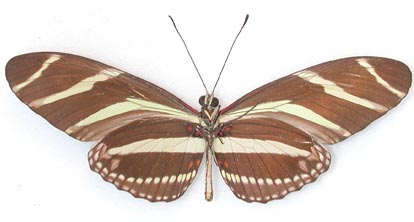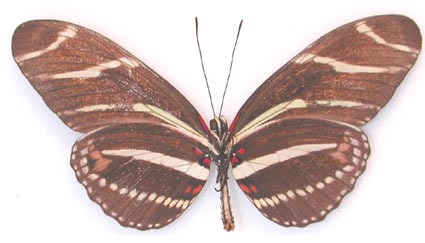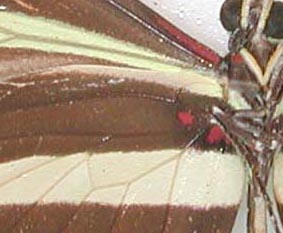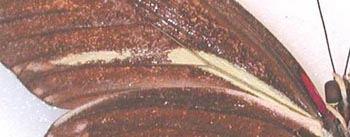
Zebra Longwing
Heliconius charithonia vazquezae and Heliconius charithonia tuckeri

Above: Heliconius charithonia vazquezae Dorsal

Above: Heliconius charithonia tuckeri Dorsal

Above: Heliconius charithonia vazquezae Ventral

Above: Heliconius charithonia tuckeri Ventral

Above: Heliconius charithonia vazquezae
Close-up of ventral hindwing showing yellow band extending
beyond the discal cell.

Above: Heliconius charithonia tuckeri
Close-up of ventral hindwing showing yellow band just touching the lower
edge of the discal cell.

Above: Heliconius charithonia vazquezae
Close-up of ventral forewing showing solid yellow band.

Above: Heliconius charithonia tuckeri
Close-up of ventral forewing showing broken yellow band.
Heliconius c. vazquezae, the Texas subspecies: On the hindwing the yellow band is thicker, extending past the discal cell. This is easier to see on the ventral (underside) side. Also on the ventral side, on the forewing, the yellow band is thick and continuous.
Heliconius c. tuckeri, the Florida subspecies: On the hindwing, the yellow band is thinner, just reaching the edge of the discal cell. This is easier to see on the ventral (underside) side. Also on the ventral side, on the forewing, the yellow band is thin and usually broken, sometimes being almost nonexistent. This is quite variable.
Other traits:
Heliconius c. vazquezae: The dark coloring is a more brown appearance; the bands of yellow have a somewhat orange tinge.
Heliconius c. tuckeri: The dark coloring is a darker brown/black; the bands of yellow are almost greenish/lime colored.
Natural range:
Heliconius c. vazquezae: Mexico, Arizona, New Mexico, Texas, northward to Oklahoma, Kansas, rarely further north.
Heliconius c. tuckeri: Florida, Georgia, South Carolina. Mississippi and Louisiana??